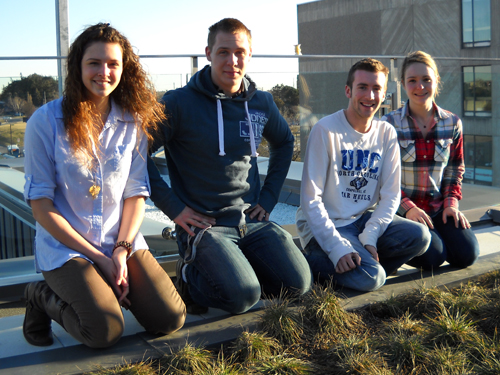
That ground-floor corner classroom in the new Thornbrough Building addition serves as their engineering design studio. But in a way, the entire atrium addition opened late last year across from the University Centre is a brand-new teaching lab for U of G engineering students learning about sustainable design.
From a green roof and rooftop wind turbine to a basement cistern collecting rainwater, the new four-storey addition at the northwest corner of the engineering building provides a number of built-in teaching aids for instructors and students.
“We regard the building as a teaching tool,” says Phil Watson, the school’s lab manager.
That idea – building as lab – is a rarity for engineering students on many campuses, says Prof. Ryan Clemmer. But it’s a boon for the 160-odd students in the third-year design course he’s teaching this semester along with Prof. Bahram Gharabaghi – and indeed for most engineering students in Guelph’s design-based learning programs.
“The building lends itself well to the design course,” says Clemmer, who joined U of G’s growing School of Engineering in January. “You can actually see the systems in place. Engineers are visual by nature. It’s a real-life visual aid.”
A number of features in the new addition serve as teaching aids.
Students will have supervised access to the penthouse mechanical systems. Besides inspecting engineering and architectural designs, they can obtain data about use of steam, electricity, water and gas – perhaps to compare consumption patterns over different periods.
That kind of information gives students a real-life context for their learning, says Wilfred Ferweda, project manager for the ongoing renovations to Thornbrough and the adjoining Richards Building. “Instead of getting data out of a textbook, they can get data out of the building.”
Along with staff from Physical Resources, groups of engineering faculty, staff and students also looked to include sustainable design features in the new addition. A small wind turbine and solar panels will be installed on the roof for studies of alternative energy.
Already on the roof are seven plots containing plant species common in green roof designs for moderating building temperatures and filtering rainwater. In Thornbrough, that water collects in the new basement cistern; from there, it’s pumped for use in flushing toilets.
One group of students is currently using that system to study rainwater harvesting, also a research interest of several of the school’s water resources engineers.
Student Rob Dickson wonders whether other campus buildings might one day be similarly outfitted. Referring to the Thornbrough system, he says, “It’s like a learning tool. It’s not big, but it sets an example for the rest of the University.”
The group is learning how green roofs help to clean and moderate the flow of rainwater. Says Jurgen Koehler, “There’s a collection area below the roof where you can extract water. You can take a sample and see how the vegetation affects the quality of the water coming through the roof.”
Adds Ferwerda: “The building becomes part of your experiment.”
Other groups this semester are studying sustainable designs based on facilities on campus and off, including geothermal energy and the use of food and farm waste to generate energy.
Last month, the class heard a talk by Prof. Maurice Nelischer, U of G’s director of sustainability. “The students are working on projects all over campus and the region,” says Nelischer. “I hooked a team up with Physical Resources regarding energy usage in University kitchens, in the engineering building before and after the retrofit, and green roof technology.”
Ferwerda says the atrium space itself supports teaching and learning for engineering students and others. Seating and tables on the ground floor provide study space – a “hot topic” on campus, he says – and encourage students to work in groups.
Along with adjoining rooms and a large ceiling-mounted screen, the new space also works as a multipurpose venue with breakout spaces for small symposiums or lectures. Patio-style doors facing the UC will allow groups to bring in large items or will serve as a larger entryway for people attending, say, the school’s capstone design presentations.
Beyond the school, the new space will also accommodate campus-wide events, including two gatherings planned for March by the president’s office. “It’s going to suit these functions very well,” says Ferwerda.
Besides teaching space, the addition houses sustainable energy labs, a robotics research institute and a lab run by the School of Computer Science. An official opening is planned for April 11.